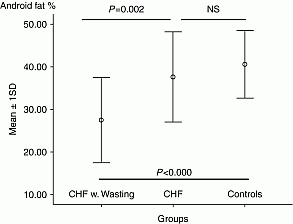ICEECE2012 Poster Presentations Cardiovascular Endocrinology and Lipid Metabolism (74 abstracts)
Body composition and association to NT-proBNP and myostatin levels in heart failure patients
H. Christensen 1 , C. Kistorp 1 , M. Schou 2 , B. Zerahn 1 , N. Keller 1 & J. Faber 1
1Herlev Hospital, Herlev, Denmark; 2Rigshospitalet, Copenhagen, Denmark.
Objectivs: Plasma NT-proBNP is inversely associated with BMI in patients with heart failure (HF). A possible mechanism may be the lipolytic effect of natriuretic peptides on abdominal fat.
Myostatin is previously described as a negative regulator of skeletal muscle mass in cachexia.
We assessed the hypothesis that body composition is related to plasma NT-proBNP and that myostatin levels are associated with loss of fat free mass (FFM) in HF.
Methods: We included 57 patients (19 with systolic HF and cardiac cachexia, 19 HF patients without cachexia and 19 patients with prior MI). The groups were matched by age and gender, mean (S.E.M.) age 78.3 (1.0) years and 79% males. Body composition was assessed by DEXA, measuring FFM and fat mass as well as fat distribution.
Results: In univariate linear regression analyses abdominal fat % was inversely associated with NT-proBNP (β=−0.30; P=0.025) no association with gynoid fat % (P=0.51), FFM % (P=0.20) nor total body fat % (P=0.12) was observed. Multivariable linear regression analysis adjusted for well-established predictors of NT-proBNP (LVEF, kidney function, NYHA functional class and age) demonstrated no attenuation (β=−0.28; P=0.018) in this association.
No correlation between serum myostatin and fat free mass (β=−0.058; P=0.67) was observed. Mean (S.E.M.) myostatin was significant lower in the cachexia group (5.2 (0.3) ng/ml vs 6.2 (0.5) ng/ml and 6.7 (0.5) ng/ml, respectively; P=0.036).
Conclusions: Reduced abdominal fat mass was independently associated with high NT-proBNP, suggesting NT-proBNP could be related to the body composition alterations observed in HF patients with cachexia. The lack of association between myostatin and FFM was unexpected. However, the fact that myostatin was reduced among HF with cachexia raises the possibility that myostatin plays a secondary protective role in muscle loss in cachexia and has no primary involvement in pathogenesis.

Declaration of interest: The authors declare that there is no conflict of interest that could be perceived as prejudicing the impartiality of the research project.
Funding: This research did not receive any specific grant from any funding agency in the public, commercial or not-for-profit sector.
 }
}



